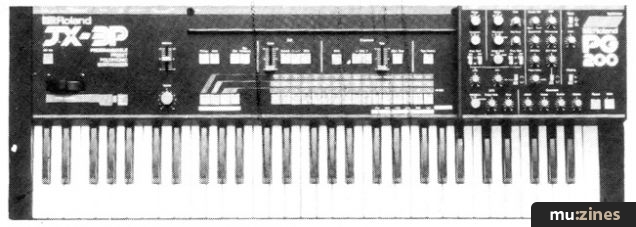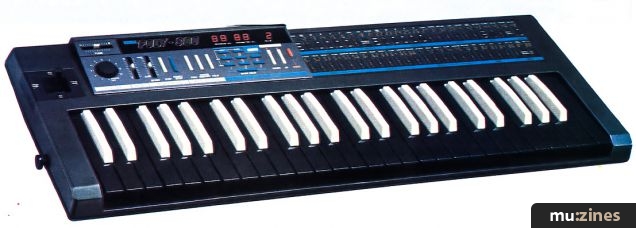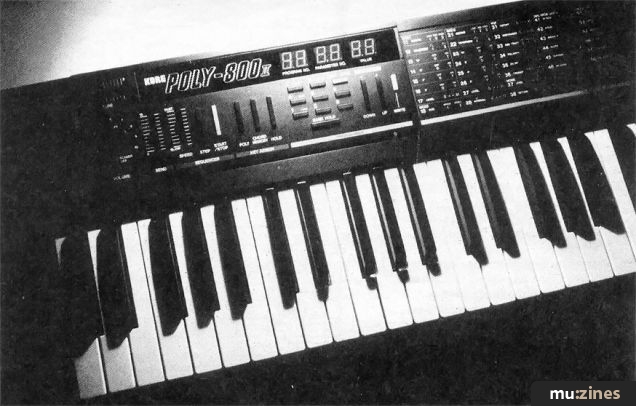Magazine Archive
Home -> Magazines -> Issues -> Articles in this issue -> View
Customise (Part 1) | |
Article from Electronic Soundmaker & Computer Music, July 1985 | |
New sounds for the Poly 800
The first in a series that shows how you can get the best sounds out of your synth. This month Sam Griffiths looks at the Korg Poly 800. (Software on tape).

The Poly 800 is a hybrid machine, consisting of both analogue and digital circuitry.
The sounds the Poly 800 produces are of course "analogue" in nature, in spite, perhaps, of appearances, as there is no direct digital role in sound generation. There are 8 Digitally Controlled Oscillators with two waveforms and variable harmonic content, which can be configured in two banks of four. There are 9 six-stage Digital Envelope Generators, 8 of which control Voltage Controlled Amplifiers attached to the DCO's, and one for the Voltage Controlled Filter and/or the noise generator, again via a VCA. There is also a Modulation Generator, a Low Frequency Oscillator, which can modulate the DCO frequencies or the VCF cut-off frequency. In short; there are 8 tone generators (DCO's), 8 "envelope shapers" to control their volume, and one to control the volume of the "noise" source or to change the highest pitch the filter will let through. The MG tends to produce vibrato or wah-wah effects. The powerful features of this system are the wide range of basic sounds the DCO's can produce, thanks to the selectable harmonics, and the very versatile envelope shapers. In particular, this means that when the instrument is in "double" mode (2 banks of 4 oscillators), the sound can be made to vary during notes simply by altering the relative volumes of the 2 banks using the DEG's. You can get effects like this which you can't get by sweeping a filter. The ability of the envelope shapers to produce a second attack or decay in addition to or without the sustain-release stage means a large range of envelopes can be achieved, including realistic string plucking, impact or percussive sounds.
The detuning capacity means that you can get rich, and even rough, "analogue" sounds, and the "interval" parameter means you can set the two banks to play completely different notes. Also of particular interest is having the noise generator under the control of a 6-stage envelope generator.
To be avoided where possible in programming — the single low pass filter, through which the entire output is routed, hampered even more by the inflexible modulation options.
For example, you can't synthesise drums because you need to take the filter resonance down to smooth out the bass from the DCO's, and this obliterates the wonderfully enveloped noise burst that was going to go with it. Also you can't just modulate one bank of DCO's using the MG — you have to modulate both.
The most oft-mentioned weakness is having only one filter for all 8 DCO's, instead of a bank of 8. This results in the sound of a note (generated by a voice program that uses the filter) being dependent on what others are being played. This means that the Poly 800 is, ironically, not really functioning as a polyphonic instrument in this case.
The problem posed by only having one filter can be largely solved by deciding to do without any at all. This is quite sensible; the strong points of this machine are in its additive synthesis capabilities. All the filter can do is to subtract crudely large amounts of high frequencies from the sound. Much of the time it is worthwhile to set the filter cut-off frequency to maximum, the envelope modulation of it to zero (parameter 45), and the resonance to zero. Occasionally it is useful to bring in the filter a little when you are finishing developing a sound, but with the filter effectively removed from the system, you can concentrate on the sounds produced by the DCO's and the DEG's, and you also have the filter/noise envelope entirely available for modulating the noise source. Using this technique, truly polyphonic sounds with plenty of high frequency components can be generated.
If you aren't going to be hitting vast quantities of notes over a wide span of the keyboard — quite clearly there's no reason not to use the filter lavishly. There is a trade off here with the noise generator (because they share a DEG), and you may have to be devious to get both useful filter and noise effects. As before, I advise getting the basis of the sound right by concentrating on the DCO's and DEG's first. It's like miking something up — you aren't going to be able to get a good sound by using equalisation if it isn't there in the first place.
One of the most important things to get the hang of when programming the Poly 800 is the working of the envelope shapers. These may look offputting, but they are really just ADSR shapers with the capacity to generate a second attack or decay. The attack, decay, slope and release parameters are all rates of change (0 indicating a fast rate, 31 a slow rate), and the breakpoint and sustain parameters are levels.
Initially, the output level rises from zero to maximum at the attack rate, and decays to the breakpoint level at the decay rate. The output rises or falls to the sustain level at the slope rate, and stays there until the key is released. It then falls to zero at the release rate. If the key is released before the sustain stage is reached, then the level falls to zero from its current level at the release rate (note that the current level could be far higher than the sustain level — if an envelope you have set up behaves erratically it is probably because this phenomenon is making the length of time you hold down a key critical).
These are rates and not times. For example the decay time depends on both the decay rate and the breakpoint level. The graph on page 19 of the manual is helpful. If you set the breakpoint to maximum then the decay time is zero (the setting is irrelevant) and you have a conventional ADSR with the slope rate acting as the decay rate. Why not set up a simple waveform (putting the synth in "whole" mode so that only one envelope is involved), take out the filter as described earlier, and mess about with the DEG1 parameters until you've completely mastered them? The key to this synthesiser is in its envelope generators.
The relationship between the waveform parameter and the harmonics is actually quite simple: if all the harmonics are turned on then the waveforms parameter just selects between square and sawtooth waveforms at the fundamental frequency. For the squarewave setting, all the harmonics are available at volumes that decrease markedly relative to pitch. Given that the facilities are duplicated in the second bank and that the relative volumes are adjustable by parameters and also dynamically by the DEG's, there is an enormous range of sounds available to experiment with during programming before you need get around to filtering.
When however you do, there shouldn't be any great problem, unless it is posed by the envelope shaper (in which case see above!). I found that many of the preset sounds were too dull, and raising the cut off frequency was almost invariably a useful first modification (another one is to reduce the DEG1 and DEG2 release times, as many of the sounds are too lingering, to be useful). A key decision that you have to make with this machine is the basis on which DEG3 (the VCF envelope generator) is to be triggered. This can either be after each new key (Multi), or after a new key is pressed after all the others have been released (Single). If you leave this parameter exposed when you're playing you can alter it at the press of a button. There is of course already a chorus unit in the synth. However don't let that stop you from piling on a few more. Particularly fuzz. I guarantee that a vigorous fuzz unit will provide you with a whole new range of harder sounds.
When you're in the mood to program systematically, start with a simple envelope and turn your attention to the DCO's. Then envelope shape it, altering the texture of the sound by altering the relative volume of the DCO's, if you're in double mode. Create an extra hard attack by giving one bank of DEG's a sharp attack and decay and setting it at a high volume compared to the other. You may want to envelope shape noise at this stage too. Then, perhaps, fiddle with the modulation generator and DCO detuning, and finally bring in the filter if you need to modify the higher harmonics if it can't be done with the DCO's. Also you may need the filter and DEG3 to give the sound an extra initial bite or for other effects based on sweeping the resonant/cut-off frequency.
The Poly 800 has a standard MIDI implementation, which doesn t allow for transmission of program data, or real time manipulation of parameter settings. However, all the necessary is there for remote control or external sequencing (see June ES&CM for a suitable sequencer). The internal sequencer isn't particularly wonderful, but quite useful for exploring ideas, and it duly transmits down the MIDI bus on channel 2. Everything else whizzes down channel 1.
EXAMPLE VOICES
All you Poly 800 owners will have noticed that there's some program and sequencer data on the tape for you. Remember to save your own data before loading this in. The sequence is intended for use with voice 81 (at speed setting 7) and will probably sound lousy with most of the others.
11) Here DCO1 is the major component, with a fast attack and gradual decay, and a brassy tonal quality. DCO2 contributes to the initial attack with strings one octave down and not as loud, and then swells gently up into audibility again. The filter gives the sound an additional bite, and the MG supplies the vibrato. The DCO's are detuned for richness.
83) DCO's 1 and 2 both producing sawtooths, DCO2 one octave down. They are fully detuned, the chorus unit is on, and they are being modulated by the MG. DCO1 attacks fast, DCO2 smoothly reinforcing it with a slower attack. DCO2 then decays away, gradually smoothing out the sound, only to come in again. The filter plays no part in the proceedings.
86) I had a real instrument in mind this time — the harpsichord, or perhaps the clavicord. It is a nice simple patch, and a simple thin sounding string sound, carefully enveloped. All done by DCO1 and DEG1. 8-note polyphonic.
88) 'Atmospheric' sound. The filter is tracking the keyboard with a lot of resonance. It is not enveloped. The noise generator is enveloped: a simple AR affair, with the R being Decay or Release depending on when the key is released. The DCO's have different waveforms, different envelopes, are detuned and are playing different notes.
81) This exploits the Poly 800's capacity to produce sounds with an interesting percussive flavour. Again the filter is out of the game, leaving DEG3 free to control the noise level. DCO1 is set at a very high level, but only reaches it momentarily to make its contribution to the general attack at the beginning of the sound. Most of the time it contributes a gently developing low level bowing sound on its second attack. This is important. Try putting the synth in "whole" mode so that you just get DCO1 and can hear what it is doing. DCO2 forms the bright treble portion of the sound, actually attacking gently, although it appears to attack fast because of DCO1 and the noiseburst. The noiseburst is controlled by a simple AR envelope. The DCO's are detuned and the sound is made fuller by the MG and the chorus unit. You may want to take these off for a drier sound, and reduce DEG2's release time too, as this contributes to the sound's current resonant qualities. Sounds 22 and 51 are variations on this one, and also sound okay with the supplied sequence.
Series - "Customise"
All parts in this series:
This is the only part of this series active so far.
More with this topic
The Sensuous Envelope Follower |
Sounds Natural - The Acoustic Guitar (Part 1) |
Dave Bristow on the Yamaha DX7 - Yamaha DX Keyboards |
Music Modules for NON-Keyboardists |
Synth Computers |
All About Additive (Part 1) |
It's Cee Zee! (Part 1) |
The Lazy Guide To Good Synth Sounds |
 Rock Around the Clock |
Hands On: Yamaha DX7 |
A Deeper Wave - Wavetable Synthesis |
Sample + Synthesis - Programming Clinic |
Browse by Topic:
Synthesis & Sound Design
Also featuring gear in this article
Brian Chatton on the Poly 800
(EMM Apr 84)
Korg Poly 800 - Asia and the Poly 800
(12T Apr 84)
Korg Poly 800 Synthesiser
(EMM Feb 84)
Korg Poly-800 vs SCI Six-Traks
(ES Jun 84)
Patchwork
(EMM Aug 84)
Patchwork
(EMM Oct 84)
Patchwork
(EMM Nov 84)
Patchwork
(EMM Mar 85)
Patchwork
(EMM Jun 85)
Patchwork
(EMM Apr 86)
Patchwork
(EMM Jun 86)
Patchwork
(MT Jan 87)
Patchwork
(MT Feb 87)
...and 8 more Patchwork articles... (Show these)
Browse category: Synthesizer > Korg
Featuring related gear
Back to Back
(IM Feb 86)

Back to Back
(EMM Mar 86)
Born Again - Korg EX800
(ES Dec 84)
Korg EX800 Expander
(12T Sep 84)
Korg Poly 800 II - Polyphonic synth
(MM May 86)
Second Time Around - Korg Poly 800II Polysynth
(EMM Apr 86)
Patchwork
(MT Jun 87)
Patchwork
(MT Feb 89)
...and 1 more Patchwork articles... (Show these)
Browse category: Synthesizer Module > Korg
Browse category: Synthesizer > Korg
Publisher: Electronic Soundmaker & Computer Music - Cover Publications Ltd, Northern & Shell Ltd.
The current copyright owner/s of this content may differ from the originally published copyright notice.
More details on copyright ownership...
Topic:
Synthesis & Sound Design
Series:
Customise
This is the only part of this series active so far.
Gear in this article:
Synthesizer > Korg > Poly 800
Gear Tags:
Feature by Sam Griffiths
Help Support The Things You Love
mu:zines is the result of thousands of hours of effort, and will require many thousands more going forward to reach our goals of getting all this content online.
If you value this resource, you can support this project - it really helps!
Donations for September 2025
Issues donated this month: 0
New issues that have been donated or scanned for us this month.
Funds donated this month: £0.00
All donations and support are gratefully appreciated - thank you.
Magazines Needed - Can You Help?
Do you have any of these magazine issues?
If so, and you can donate, lend or scan them to help complete our archive, please get in touch via the Contribute page - thanks!





































